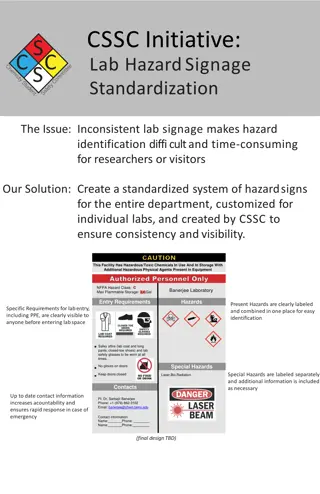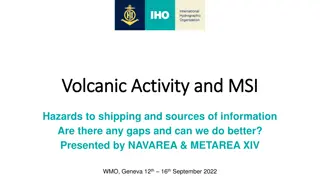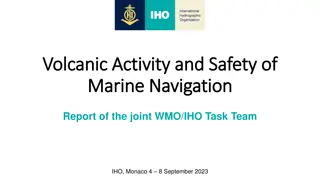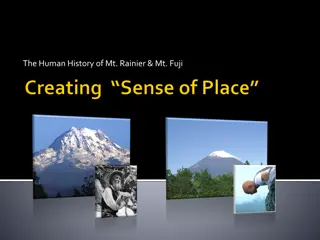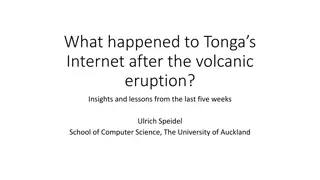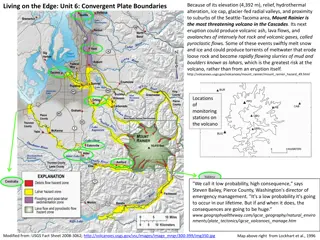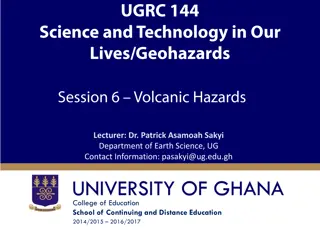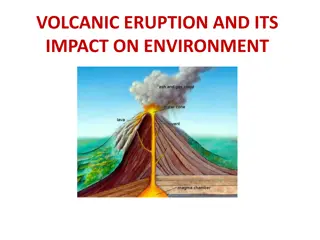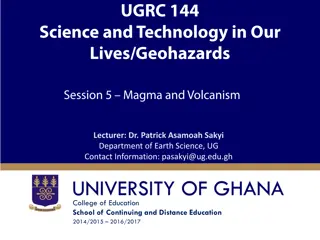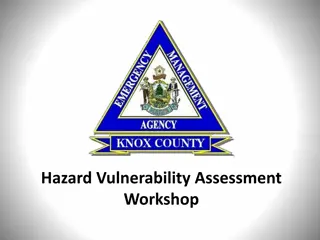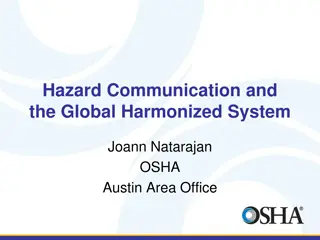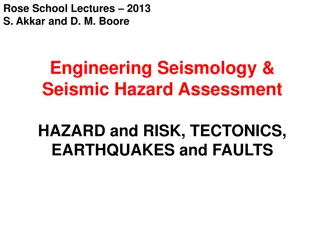Mount Rainier Volcanic Hazard Assessment
Mount Rainier, with its high elevation, hydrothermal alteration, and proximity to populated areas, poses a significant volcanic threat in the Cascades. Potential hazards include volcanic ash, pyroclastic flows, and lahars, making it crucial to monitor the volcano's activity and alert levels closely for timely responses.
Download Presentation

Please find below an Image/Link to download the presentation.
The content on the website is provided AS IS for your information and personal use only. It may not be sold, licensed, or shared on other websites without obtaining consent from the author.If you encounter any issues during the download, it is possible that the publisher has removed the file from their server.
You are allowed to download the files provided on this website for personal or commercial use, subject to the condition that they are used lawfully. All files are the property of their respective owners.
The content on the website is provided AS IS for your information and personal use only. It may not be sold, licensed, or shared on other websites without obtaining consent from the author.
E N D
Presentation Transcript
Because of its elevation (4,392 m), relief, hydrothermal alteration, ice cap, glacier-fed radial valleys, and proximity to suburbs of the Seattle-Tacoma area, Mount Rainier is the most threatening volcano in the Cascades. Its next eruption could produce volcanic ash, lava flows, and avalanches of intensely hot rock and volcanic gases, called pyroclastic flows. Some of these events swiftly melt snow and ice and could produce torrents of meltwater that erode loose rock and become rapidly flowing slurries of mud and boulders known as lahars, which is the greatest risk at the volcano, rather than from an eruption itself. http://volcanoes.usgs.gov/volcanoes/mount_rainier/mount_rainier_hazard_49.html Living on the Edge: Unit 5: Convergent Plate Boundaries Locations of monitoring stations on the volcano "We call it low probability, high consequence," says Steven Bailey, Pierce County, Washington's director of emergency management. "It's a low probability it's going to occur in our lifetime. But if and when it does, the consequences are going to be huge. www.geographyalltheway.com/igcse_geography/natural_enviro nments/plate_tectonics/igcse_volcanoes_manage.htm Above left, modified from: USGS Fact Sheet 2008-3062; http://volcanoes.usgs.gov/vsc/images/image_mngr/300-399/img350.jpg; Map above right from Lockhart et al., 1996
Living on the Edge: Unit 5: Convergent Plate Boundaries The USGS has established an alert level system to communicate the likelihood of increasing or decreasing volcanic activity. Keep these alert levels in mind as you look through the geologic activity data attached. ALERT LEVEL DESCRIPTION Volcano is in typical background, non-eruptive state or, if changing from a higher level: The activity has ceased and volcano has returned to non-eruptive background state. NORMAL Volcano is exhibiting signs of elevated unrest above known background level; or, if changing from a higher level: Volcanic activity has decreased significantly but continues to be closely monitored for possible renewed increase. ADVISORY Volcano is exhibiting heightened or escalating unrest with increased potential of eruption, timeframe uncertain OR eruption is underway but poses limited hazards WATCH WARNING Hazardous eruption is imminent, underway, or suspected http://volcanoes.usgs.gov/activity/alertsystem/index.php#alertlevel Note: Data included in the following handouts are from the USGS. References for specific figures and information can be obtained from your instructor.
SEISMIC DATA SET 1: THROUGH JUNE 8
SEISMIC DATA SET 1 (through June 8) SEISMOLOGY: EARTHQUAKES May 15th Seismograms of May 15 recorded at stations UBO and PIE (Z). Time marks in seconds are shown. Examples of seismic event types: A. VT = Volcano-Tectonic earthquake (associated with deep earthquakes indicating stress changes in solid rock due to injection or withdrawal of magma) and LP = Long-Period (associated with shallow injection of magma into surrounding rock) often associated with shallow magma movement, suggesting imminent eruption. B. Tremor-like episode of closely-spaced long- period events; C. Harmonic tremor (long-lasting, continuous release of seismic energy typically associated with shallow, underground movement of magma; harmonic tremor contrasts distinctly with the sudden release of seismic energy associated with slippage along a fault. D. Seismic signal from explosive eruption at station CAB (see map of stations in this data set). Time marks represent 1-min interval. Figures from: Harlow et al., 1996
SEISMIC DATA SET 1 (through June 8) SEISMOLOGY: EARTHQUAKES Seismogram of station UBO (note: this signal fades to the background 2 h after the Seismogram from station PIE recorded May 21. Time runs from top to bottom, left to right. Time marks are 60 sec apart. Date and time shown are local. Seismogram from May 21. Time marks are 60 sec apart. segment shown). Time marks are 60 sec apart. Figures from: Harlow et al., 1996
SEISMIC DATA SET 1 (through June 8) SEISMOLOGY: EARTHQUAKES May 6- 31 June 1-7 MAP VIEW MAP VIEW CROSS SECTION A side view of earthquake locations under the volcano (note location of line A-A on map above) CROSS SECTION A side view of earthquake locations under the volcano (note location of line A-A on map above) Figures from: Harlow et al., 1996
SEISMIC DATA SET 1 (through June 8) SEISMOLOGY: EARTHQUAKES RSAM data: recall that RSAM (Real-time seismic amplitude measurement) represents an average of absolute seismic amplitudes for seismic stations. RSAM does not discriminate between types of earthquakes, but all seismic signals are averaged and recorded. RSAM values (averages of 4 hour intervals) from May 10 to June 8 at the PIE station. EXTENDED CAPTION: Plot of (A) the SO2 volumes from May 10 to June 12; estimated from COSPEC measurements and (B) 4 hour average RSAM values from May 10 to June 12. Number of seismic events per 4-hour intervals between June 1 and June 8 from (A) the entire volcano network, (B) the cluster of seismic activity 5 km northwest of the summit, and from (C) beneath the summit. Figures from: Harlow et al., 1996
GAS, FUMAROLES & ASH DATA SET 1: THROUGH JUNE 8
GAS & ASH DATA SET 1 (through June 8) GAS & FUMAROLES Below and at right: Photos of fissure and line of new craters formed by explosions of April 2 on upper north flank of the volcano. View in photo below left: looking to the south, with prominent fumaroles in distance at the head of river drainage. View at right shows north arrow. N Right: To collect SO2 flux data, an aircraft carrying the COSPEC instrument flies the plume to measure the concentration of SO2, which is integrated over the width of the plume and multiplied by the wind speed to get the rate of SO2 emission. Upper left from Wolfe & Hoblitt, 1996; Upper right from Ewart et al., 1996; Graphic above right from Daag et al., 1996
GAS, FUMAROLES AND ASH DATA SET 1: THROUGH JUNE 8 On April 2, people in the vicinity smelled hydrogen sulfide (H2S). On April 4, a volcanology team flew over the volcano and found a chain of vigorously steaming vents across the north face of the volcano (see images in this data set). The team judged that the activity was of hydrothermal origin. Vents at the northeastern side were short lived; by the time COSPEC surveys were started, only five vents nearer to the summit were actively steaming. Plot of SO2 volumes from May 10 to June 8, estimated from COSPEC measurements JUNE SO2 emission from May 13 to June 10 Outline of areas affected by tephra fall on April 2. Left: Daag et al., 1996; Upper right: Wolfe & Hoblitt, 1996; Lower right: Modified from Lockhart et al., 1996
TILT DATA SET 1: THROUGH JUNE 8
TILT DATA SET 1: THROUGH JUNE 8 The PPO Tilt station was installed 4 km north of summit, on May 2. Two additional tiltmeters were installed during the last week of May. Starting almost immediately after installation, the UBO tiltmeter record was reasonably stable. Instrumental and logistical problems, along with the increasing volcanic activity, prevented getting useful data from the second tiltmeter. Data telemetered from tiltmeters can provide information from high-hazard areas that are too dangerous to revisit. Schematic of the UBO tiltmeter installation on the east side of the Mount Pinatubo summit dome. JUNE 6- JUNE 8 PPO tiltmeter, north side of volcano. Tiltmeters are sensitive to even slight changes in temperature, so burial 1 to 2 m deep is necessary in order to isolate the instrument from diurnal temperature changes. From Ewert et al., 1996
GAS & TILT DATA SET 1 (through June 8) TILT RADIAL DATA: increasing values indicate west up, or edifice inflation. gas + ash emission rain MAY 31 JUNE 4 May 31-June 3: Data from the tiltmeter located at UBO. Rainstorm on June 3 is indicated, as is the ash emission that followed. JUNE 4 JUNE 8 June 4 June 8: Data from the tiltmeter located at UBO. NOTE the change in vertical scale from previous UBO data (above). From Ewert et al., 1996
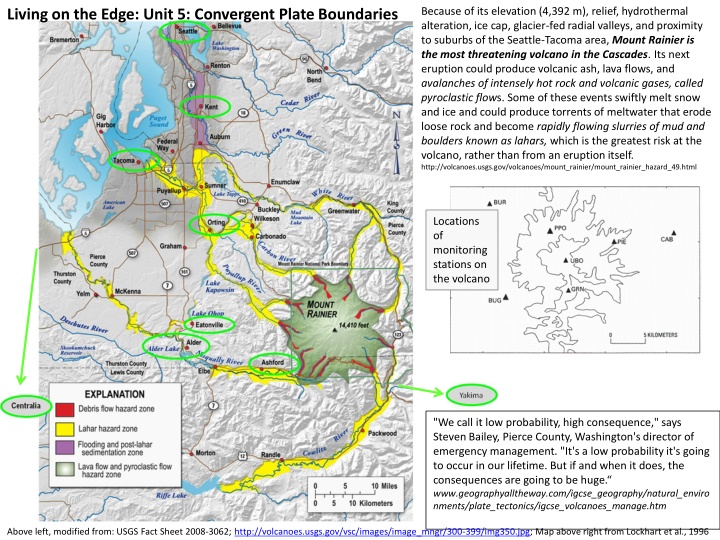

![Read⚡ebook✔[PDF] Io After Galileo: A New View of Jupiter's Volcanic Moon (Sprin](/thumb/21612/read-ebook-pdf-io-after-galileo-a-new-view-of-jupiter-s-volcanic-moon-sprin.jpg)



